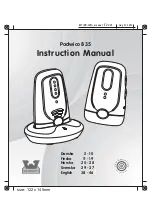
Instructions for Use
– SCHMIDT
®
Flow Sensor SS 20.600
Page 28
Exceeding measuring range of flow velocity w
N
Measuring values larger than w
N,max
are output linearely up to 110 % of
the signaling range (this corresponds to 11 V resp. 21.6 mA, see
graphics in Table 7). At higher values of w
N
, the output signal remains
constant.
In that case an error signaling does not take place because damage of
the sensor is unlikely.
Medium temperature T
M
outside specification range
Operation beyond the specified limits can lead to damages of the sen-
sor and, therefore, is seen as a critical error. This leads to the following
reaction depending on the temperature limit (also refer to the graphics
in Table 8):
o
Medium temperature below lower temperature limit:
The analog output for T
M
switches to error (0 V or 2 mA)
21
.
The measuring function for the flow velocity is switched off its analog
output also signals an error (0 V resp. 2 mA).
o
Medium temperature above 120 °C
T
M
is output in a linear way up to at least 130 °C, e.g. to enable over-
shooting of heating control. The flow velocity is measured and dis-
played further on.
Above this critical limit, flow measurement is switched off and the
analog output w
N
switches to error signaling (0 V or 2 mA). The signal
output T
M
switches directly to the maximum possible values of 11 V
resp. 22 mA, in opposition to normal error signaling.
This prevents that a heating control which is using the medium tem-
perature measuring function of the sensor gets into a critical self-ex-
citation in case of overtemperatur. A normal error signaling (0 V or
also 2 mA) could be identified by the control as very low temperature
of the medium which would lead to further heating.
21
The switching hysteresis for the threshold is approx. 5 K.













































